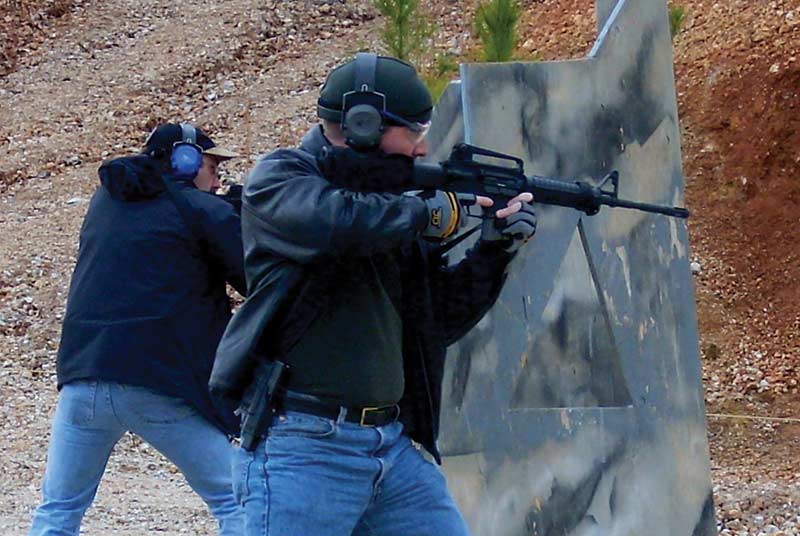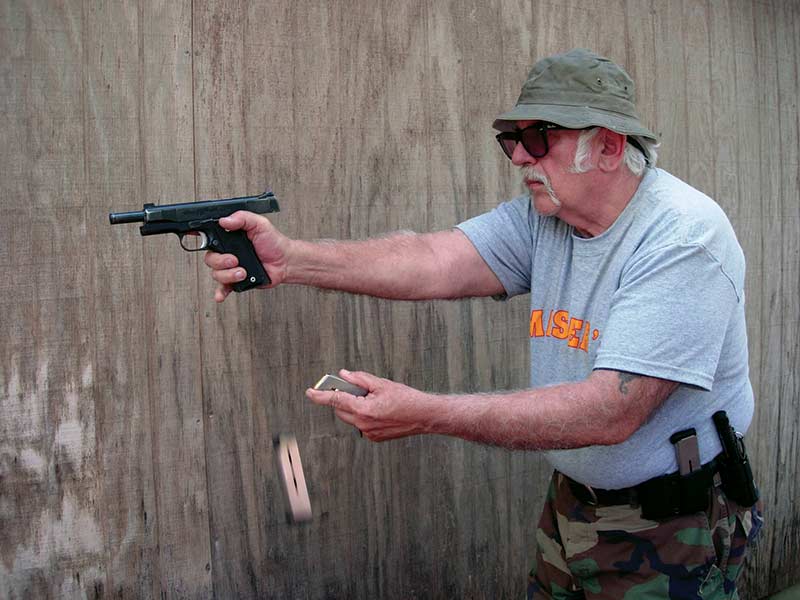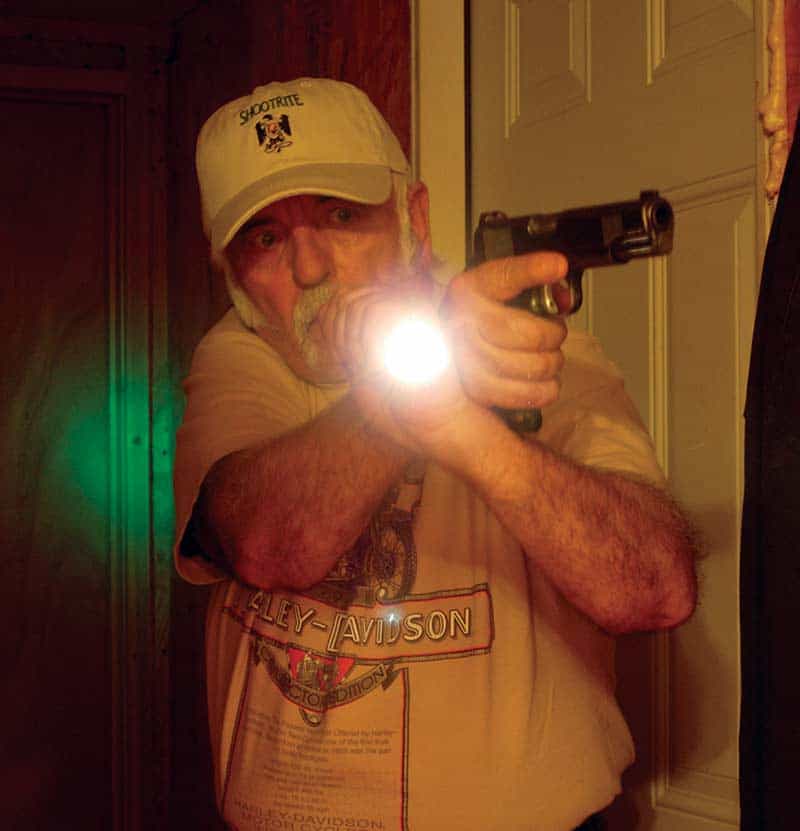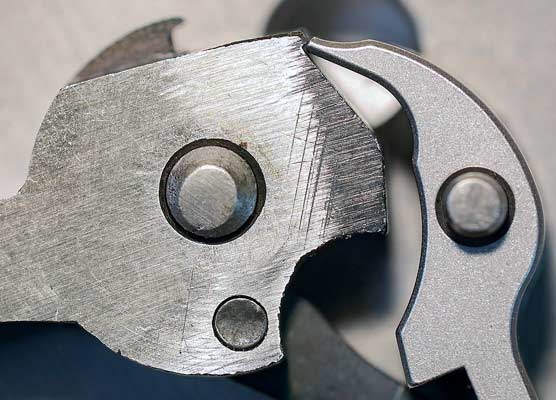Practice For The Fight
The Skills You Need
Fights are dynamic and violent, and unpredictable. When and where will your fight take place? Answer that and you could avoid it completely, or if necessary prepare to face your opponents with overwhelming force.
We don’t know how many threats we’ll be fighting, but statistics say: A) there will be more than one, B) they’ll be at close range, and C) you’ll be fighting in a low-light environment. What will it take to win? Anything from avoidance and escape, verbal commands with the presence of a weapon, or actual combat. And, although we know the combative portion of the fight is normally short — probably only a few seconds — there is always the possibility of an extended confrontation.
Although the details of combat are unpredictable, these fundamental skills will come into play: movement, communication, employing your weapon, the use of cover, and the ability to operate in low-light environments. Your command of these skills will determine the outcome of the fight. Obviously it’s a good idea to learn them and practice them constantly. Experts say it takes thousands of repetitions before we can apply any skill at a subconscious level, which frees up our conscious mind to focus on handling the many unknown variables of the fight.
Movement
During combat we move for a variety of reasons. Creating distance between our opponent and us reduces the chance of injury, regardless of the weapon our opponent is armed with. Distance equals time, and time allows us options. If shooting is necessary, this extra time translates to more hits on the threat. We may move to obtain a clear angle of attack that does not endanger bystanders. We move to avoid the line of the threat’s attack. A threat armed with a knife charges you. As he gets close you sidestep to the right. Now he has to slow down to redirect his attack. Again we’ve purchased more time. We move to cover. If cover is just a couple of feet from me, I get to cover and then focus on shooting. If there is no cover close we’re moving to present the threat with a mobile target instead of a stationary one.
Movement during a fight combines both physical and mental skills. Physically we must move in a manner that prevents us from losing our footing. Falling down in a fight is not cool. Shooting while moving requires a stable platform, with movement taking place in the legs and feet, while the upper body remains stable, reducing any motion, making it difficult to maintain a sight picture. We can move smoothly and shoot accurately, or move quickly and not fire. One situation may require both techniques
Don’t Grow Roots
Once we decide to fight our tendency is to root to the ground and fight. This makes sense if you think about our natural instinct, which is programmed for fighting with our hands, feet, teeth, clubs or impact weapons, or knives we use as claws. But it makes no sense in a gunfight. The beauty of firearms is we don’t have to be close to use them. The natural desire to be stationary when fighting must be rewired through repetitive practice. If you don’t have a range where you can shoot and move, then practice shooting at the range and work on movement at home using a dummy weapon.
Communication
Communication is a key tactical skill often overlooked. We communicate with threats. “Leave my home now!” “Stop, drop the weapon!” Millions of times every year the presence of a weapon and strong verbal commands diffuse a possible violent confrontation. An armed citizen communicates with family members, giving them instruction on where to go or what to do. Armed professionals communicate with teammates to co-ordinate tactics. And although this may sound funny, sometimes it’s good to talk to yourself; verbalizing your actions often helps maintain mental focus.
Communication works best when it’s short and simple. Use names when possible to get someone’s attention. And remember communication is a two way street. I talk to my dogs, but I communicate with my wife. Since communicating consumes a large part of our brain’s resources it’s necessary to practice it in advance, otherwise we probably won’t do it in a fight.
Employing a firearm properly requires you to be a craftsman. The firearm is your tool, and you have to train and practice in order to use it effectively. You have to be able to apply the fundamentals of marksmanship — aim, hold, press, and follow through — under any circumstances. We aim by obtaining the sight picture necessary for the shot we’re attempting. Hold that sight picture steady, and smoothly press the trigger without flinching or anticipating recoil. Then, because we know multiple shots will probably be necessary, we follow through by recovering from the recoil, reacquiring a sight picture, and resetting the trigger in anticipation of firing again.
Devil Is In The Details
Manipulation skills are important. Your weapon runs empty. You reload efficiently and get the weapon back into the fight without delay. There’s no time to think about how to reload, it just has to happen. Ditto for clearing malfunctions if they occur, and they will. These actions must be practiced until you can perform them in the dark, with someone attempting to kill you, and under short time constraints.
Use cover, which provides a physical barrier between you and the threat’s weapon, whenever possible, even when you think the fight is over. The threat attacks. While withdrawing you fire and he drops to the ground. Scanning, you notice a concrete block wall, so you move to get behind it. And just in time, because the threat’s “pardner” runs up, grabs his friend’s weapon and begins shooting at you.
When using cover there are a few principles we need to apply, keeping in mind there are exceptions to each of these tactics. When possible, create distance between you and the object you’re using for protection. This reduces the danger of being injured by fragmentation and debris created by incoming rounds. This distance also opens up your field of view, allowing you to see more of what’s going on in your environment. Creating this distance is often difficult because it’s completely contrary to our natural instincts; the closer we hug cover the safer we feel. This is a false sense of security. Remember, most objects in your environment offer a certain degree of protection, but they are not bullet proof. It doesn’t take that many pistol rounds, and even fewer high velocity rifle rounds, to punch a hole in a block wall. Don’t discount the value of concealment. While it doesn’t offer any ballistic protection, sometimes it can be effective. If they don’t know where you are the chances of them shooting at you are reduced.
Low Light
Another important skill is the ability to fight in low-light conditions. Over 70% of violent confrontations occur in low-light environments, yet the majority of our training and practice occurs in the daylight. Learn to fight with hand-held lights. Weapon mounted lights will fail, usually when you need them most, and a hand-held light offers more versatility. You’ll probably need several lighting techniques to solve one problem. For example you already have the light in your hand, but your pistol is holstered. The quickest technique to use when drawing the pistol is the jaw index method, where the light is positioned against the side of your jaw as you present your weapon. For working around the right side of cover, or a corner to the left, the light should be on the right side or your weapon. When using the left side of cover, or clearing a right hand corner, the light is on the left side of the weapon. Switching sides with the light provides maximum penetration of the light into the environment, and reduces the amount of reflection back onto you. Modifying the old F.B.I. technique by holding the light off to one side or the other allows you to scan the environment while keeping your weapon indexed on the last known threat or area of concern.
Complete Package
Tactical skills — movement, communication, weapons operation, using cover, and low-light techniques — aren’t things you can learn on your own. Reading or watching videos is good, but to blend these fighting skills into one package requires training under a qualified instructor. After training comes learning, where through practice and repetition you reach the point you can apply these skills at a subconscious level. Again: functioning at the subconscious level frees the conscious mind to think about the fight.
Start the fight with plan A, but it won’t go like you think, so have plans B and C ready. Plan X is for the unexpected. No two fights are the same, so you have to be flexible and adapt as the fight unfolds. Fighting is part science and part art. Your “artwork” will be different from everyone else’s. Train, practice, learn, and remember your ultimate weapon is your brain. If you’re not thinking all you’re doing is reacting, which is a hard way to win the fight. Be prepared, and force the threat to react to what you do to them. This is your path to victory.
Subscribe To American Handgunner

Get More Personal Defense Tips!
Sign up for the Personal Defense newsletter here:









